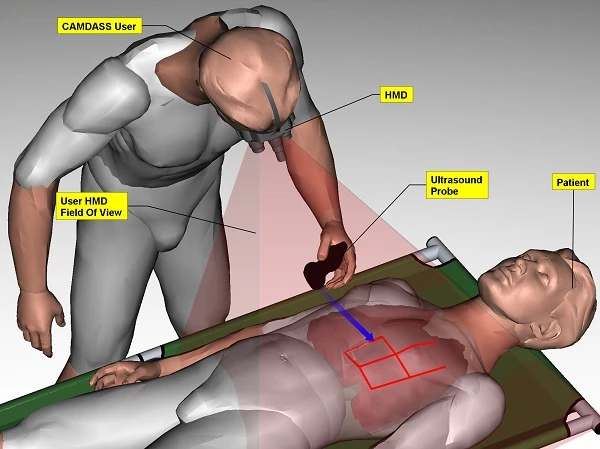Before we are able to download knowledge straight to our brains - Matrix style - gaining medical expertise will remain a slow and painful process. That's fine by most people, who can just go and visit a trained doctor. But what if you are a member of a small team of specialists operating at a remote, isolated location with no immediate access to medical resources? Then you either need to be a doctor, or you need the Computer Assisted Medical Diagnosis and Surgery System. Devised by the European Space Agency (ESA), the augmented reality-based CAMDASS aims to provide astronauts with instant medical know-how.
The underlying idea here is to provide automated, step-by-step guidance to an untrained operator of a medical device. A head-mounted display unit is used to superimpose instructional images on what the person performing the medical procedure is actually seeing. A section of the subject's body is "registered" by the system using a set of markers. The resultant image is then merged with a corresponding image of a model patient.
Currently a working prototype has been built to facilitate ultrasound examinations, already widely performed on board of the International Space Station. The ultrasound probe linked with CAMDASS is tracked by a stand-alone infrared camera. After calibration, the image of the patient's body presented to the wearer of the head-mounted unit includes 3D augmented reality cues that inform the aspiring physician on how to manipulate the probe. Further guidance is provided by reference ultrasound images, showing what the wearer should be seeing. These can be controlled by voice commands.

Untrained users who participated in tests carried out at Saint-Pierre University Hospital in Brussels reported they were able to perform fairly complicated procedures on their own, without any external help. "Based on that experience, we are looking at refining the system - for instance, reducing the weight of the head-mounted display as well as the overall bulkiness of the prototype," explained Arnaud Runge, a biomedical engineer overseeing the project for ESA.
Ultrasound examinations are, of course, just the tip of the iceberg in terms of possible medical applications. With the right extensions and modifications, the system could possibly be used even for surgery. The researchers already plan to do more testing in remote locations (such as the Concordia Antarctic base) as well as in developing countries. Eventually, should terrestrial tests show satisfactory results, the telemedicine system is planned to be used for remote medical assistance via satellite.
Source: ESA







